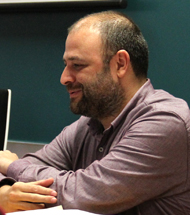Socotri: an ancient Yemeni oral language develops writing in the 21st century
Leonid Kogan, professor at the Higher School of Economics in Moscow, explained on the framework of an ICS congress how a group of Russian linguists created this writing system from Arabic.

PHOTO: Elena Beltran
In the Indian Ocean, marked by the tip of the Horn of Africa, lies the island of Socotra, in an archipelago belonging to Yemen. It is a unique enclave, included since 2008 in the UNESCO World Heritage List for the enormous diversity of its flora and fauna. Among its riches, it has an intangible treasure: the Socotri language, an ancient Semitic language spoken by some 100,000 people and which, until a few years ago, survived only orally between parents and children.
In the second decade of the 21st century, a group of Russian linguists, at partnership with a group of local intellectuals, developed a writing system for this language, based on the Arabic alphabet. The team included Leonid Kogan, a professor at high school of programs of study of Oriental and Classics at the Higher School of Economics in Moscow.
The expert spoke about the passage from orality to writing in the socotrí at an internationalcongress on transitional texts organized by the Institute for Culture and Society (ICS) of the University of Navarra. The activity was part of the project ORFORCREA 'Between formulas: creativity in oral and transitional poetic texts', developed by Sarali Gintsburg at 'Public discourseThe activity is funded by the European Union's Horizon 2020 program research and Innovation, with a scholarship Marie Sklodowska-Curie.
"The will to preserve and develop the writing for Socotrí came from the island's speakers, who consider it an essential element of their ethnic and cultural identity. It was not something external, but rather came from a social demand", says Professor Kogan, who indicates that despite having few speakers, this language "presents good prospects for the future".
Promotion and prestigeSocotri is related to Arabic, but they are completely different, according to the specialist: "Between them there is a level of mutual understanding similar to that which exists between English and Icelandic; that is to say, none". Despite this, he notes that in a part of the Eastern world where the written word is 'venerated', the consideration of this oral language was so leave that many believed it to be a dialect. "The development of the written system," he continues, " has been decisive in promoting its prestige, which has grown enormously.
The expert points out that in the creation of the writing system, the starting point was Arabic, to which four elements were added to capture the phonemes of Socotri. But the main difficulty was not only a question of the alphabet: "The challenge was to develop a complex inventory of orthographic rules, of writing rules for various morphological positions and for linguistic phenomena that are sometimes very complex".
The process has not yet been Closed. In 2014 the first book systematically using the new Socotrian script was published and 85% has been stable, while the rest is still fluctuating. "The second Issue will see the light in a few weeks and the script is still not 100% stable," says Kogan. Thus, he points out that "each new meeting from the team brings with it new developments that show obvious progress."
Leonid Kogan stresses that, for a specialist in Semitic languages like himself, Socotrian is "a mine of discoveries" not only from a linguistic point of view, but also from a cultural, poetic and even religious point of view. "We have learned a lot from this very original, isolated and archaic culture, with interesting parallels with the biblical world," he stresses. And at last the popular traditions, stories and poems of the local language can be put down on paper.
Islamic religious literature"There is also quite a demand for creating and publishing literature of an Islamic religious nature," he adds. This is important, as the island's population has undergone a strong Islamization since the 1990s, Kogan recalls, and until recently in many circles "local traditions and language were perceived as opposed to the ethical and social norms established by that religion." Against this, he mentions that in Socotra's intellectual circles "there is a growing feeling of rejecting the opposition; a balance between Arab and Islamic religious values and local tradition is believed to be possible".
As an example, he mentions that one of the collaborators of his team, a professor of Islamic sciences at a high school, has created a couple of compositions of religious character in socotri and a rich inventory of local narrative tradition in line with Islamic orthodoxy.
The next step is, from agreement with Kogan, for speakers to learn to write it, both children in kindergartens and schools as well as the adult population. "If the political and social circumstances on the island allow it, which is an acute question," he stresses, "it is highly likely that the system will be adopted as an effective means of teaching. For that, political will is surely needed, something we cannot get mixed up in". It should be recalled that the circumstances in the Republic of Yemen are complicated, as the country is embroiled in a civil war involving Saudi Arabia and Iran.
The work has also had an impact on the academic community, especially among scholars studying languages related to Socotri. Leonid Kogan comments that in Oman and Yemen there are two other oral languages whose communities are interested in becoming written languages with an established orthography. These efforts keep alive the hope of preserving a bequest that belongs to all humanity.





